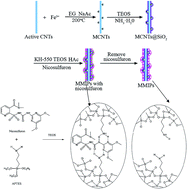Analysis of sulfonylurea herbicides in grain samples using molecularly imprinted polymers on the surface of magnetic carbon nanotubes by extraction coupled with HPLC†
Abstract
A new strategy for the isolation and enrichment of sulfonylurea herbicides in grain samples was obtained by using magnetic molecularly imprinted polymers (MMIPs) using carbon nanotubes as the matrix, nicosulfuron as the template molecule, 3-aminopropyltriethoxysilane as the functional monomer, tetraethyl orthosilicate as the cross-linker and cetyl trimethylammonium bromide as the dispersant. The characteristics of the MMIPs were assessed by transmission electron microscopy, vibrating sample magnetometry, X-ray diffractometry, elemental analysis, the Brunauer–Emmett–Teller method and Fourier transform infrared spectroscopy. The binding characteristics of the imprinted materials were researched using isothermal adsorption experiments, kinetics adsorption experiments and selectivity experiments. The recoveries of four sulfonylurea herbicides were more than 80.0% and the detection limits were 0.0107, 0.0151, 0.0147 and 0.0123 μg g−1, respectively. RSDs of intra-day and inter-day precisions in the range of 0.7–2.4% and 5.3–8.4% were obtained, respectively. The results demonstrate that MMIPs are promising for the preconcentration, purification and analysis of sulfonylurea herbicides in grain samples.


 Please wait while we load your content...
Please wait while we load your content...